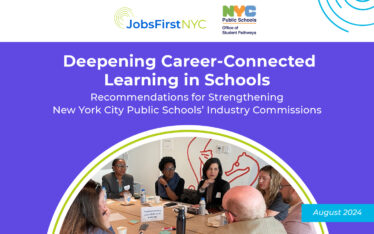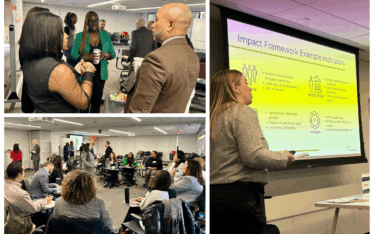March 11, 2020
New York City’s transfer high schools are designed to serve students who have struggled to make progress in traditional high schools. Even with additional help, however, the students enrolled in transfer schools typically face greater barriers to success: Only half of them graduate with a high school diploma, and only a handful go on to complete postsecondary education. Absent new approaches, students in these schools run an imminent risk of joining the 118,000 out-of-school, out-of-work young adults in New York City at a time when the economy requires more skilled workers.
To change these odds, JobsFirstNYC and New Visions for Public Schools have launched a new pilot project—the Transfer 2 Career Collaborative (T2C)—connecting 12 transfer schools in the New Visions network and 11 local workforce development organizations. Educators and workforce development staff come from two different worlds: Many educators view schooling as a long game, where change is slow and methodical and where impact may not be seen for some time; on the other hand, workforce development practitioners must move quickly to keep up with changes in the labor market and economy. To meet employer needs, workforce providers must be nimble, constantly adapting their training and offerings to provide their clients with the best opportunities for job placement and future success. The two fields have their own languages, systems, missions, and outcomes, but they serve the same communities and work with the same young adults at different points in their lives. And they both care about providing people with the education and opportunities to have successful futures.
The T2C pilot brings together both of these worlds to identify challenges, incubate new ideas, and advance what works. We believe that transformative change happens from bringing together traditionally isolated groups in a structured and collaborative way. The T2C initiative leverages a thoughtful five-step process to forge effective and sustainable partnerships to improve transfer high school students’ postsecondary pathways.
Investigate
After more than a year of research, learning, and planning, JobsFirstNYC and New Visions identified three principal goals for the project:
- Provide career awareness and exploration services to all transfer high school students.
- Integrate programming that bridges these students’ transition from high school to postsecondary and training programs.
- Increase opportunities for students to gain the postsecondary credentials needed to access pathways to growing sectors of the local economy.
Imagine
In January 2018, we publicly launched the partnership via a series of community meetings to help key stakeholders imagine new ways to achieve the goals we had defined. We solicited feedback from educators, workforce providers, philanthropists, and advocacy groups.
The first gathering highlighted the importance of connecting transfer high school students to growing sectors of the economy and discussed the value of partnerships and school-wide collaboration in creating better outcomes for young adults. The following public meeting brought together school and workforce development leaders to start strengthening relationships and identifying opportunities for greater collaboration.
We also released a Request to Participate, seeking ideas from New York City’s top workforce development organizations serving young adults that are committed to creating new solutions to help transfer school students on their path to meaningful careers.
After reviewing more than two dozen impressive proposals from prospective partners, 11 organizations were invited to join a learning community and build partnerships with 12 transfer high schools. Workforce partners selected include: Bronx Community College, Comprehensive Development, East Side House Settlement, The HOPE Program, The Knowledge House, LaGuardia Community College, NPower, Opportunities for a Better Tomorrow, Phipps Neighborhoods, Queens Community House, and St. Nicks Alliance.
Incubate
Each workforce organization received a planning grant to participate in a cross-organization learning community and to collaborate with school leaders from one or more transfer schools to design new models and develop targeted approaches to preparing students for career success while still in school. We also invited leadership from each of the organizations with the New York City Department of Education Learning-to-Work contracts into the learning community. The Learning-to-Work program provides a range of wrap-around support services, including advocate counselors for students, paid internships, and intensive case management.
Starting in the spring of 2018 and continuing through the 2018–2019 school year, we brought these groups together for ten day-long Learning Community sessions to help build shared understanding and clear roles and responsibilities. “School Design Teams” were formed as a collaboration between school leaders, workforce partners, Learning-to-Work leadership, and other key staff. These teams worked to solidify goals, program components, and initial work plans. In those early meetings, it was clear that each entity knew so little about one another’s goals, practices, cultures, funding streams, policies, and systems but were hungry to learn about each other. Sharing information and building relationships was thus a key first step.
Implement
As we moved into the second school year of this initiative, the School Design Teams drafted new strategic implementation plans and began piloting student-facing programming. Early student outcomes and insights are continuously documented and reported so they may be shared across the community of practice.
Chief among our early insights is a need for more on-site coaching and technical assistance to support School Design Teams on the ground. Partnerships are working on a range of implementation challenges including structure, programming, curricula, and social-emotional support, school and organizational cultures, and partnership goals and sustainability. To more fully support partnerships, JobsFirstNYC hired a Director of Postsecondary Innovation to drive project strategy and partnership development on the ground, and New Visions also hired a Career Readiness Program Manager to lead the development and management of a transfer school career readiness coaching strategy from within the network.
JobsFirstNYC and New Visions have also been creating and iterating series of partnership development tools (rubrics, work plan templates, and memoranda of understanding) and have been curating resources to share with partners. We also are working hard to ensure that our data systems keep up with the T2C models being designed and tested.
Integrate
Although the T2C initiative is still in its implementation phase, we’re already tracking our performance and beginning to advance the most successful approaches across our network. In the coming months, we plan to share critical insights gained thus far. We are also planning ahead for next year, as we have big ideas to create more sector opportunities for students, collaborate with school leaders during the school day, and build economies of scale across partnerships. In the end, we hope that our work will help others establish partnerships between schools and workforce development organizations to enhance career exploration and readiness, provide early on-ramps to postsecondary pathways, and improve education and employment outcomes after high school for our most vulnerable young adults.
Learn more about T2C.
By Kevin Stump, Senior Vice President and Amanda Rosenblum, Director of Post-Secondary Innovation at JobsFirstNYC
—
JobsFirstNYC and New Visions received initial multi year funding to support this work from the New York Community Trust, Carroll and Milton Petrie Foundation, James and Judith K. Dimon Foundation, Booth Ferris Foundation, and the Jeffrey H. and Shari L. Aronson Family Foundation. We are also grateful to the Achelis and Bodman Foundation, Altman Foundation, Annie E. Casey Foundation, Carl C. Conway Scholarship Foundation, and Cummings Memorial Fund for their early support.
We continue to seek funding to support the next few years of this pilot and are working to connect our partners to the public and private resources that they will eventually need to sustain their efforts.



